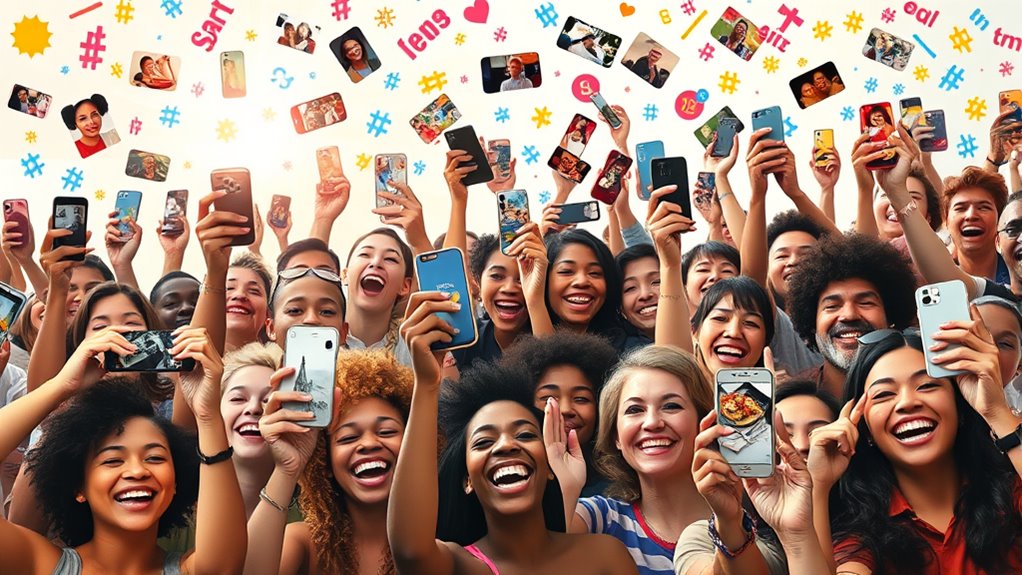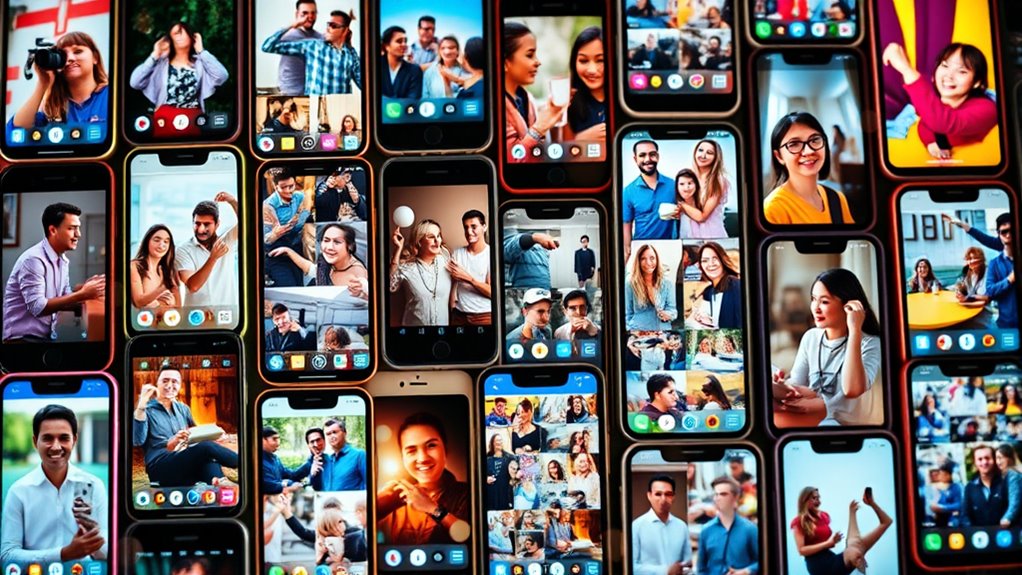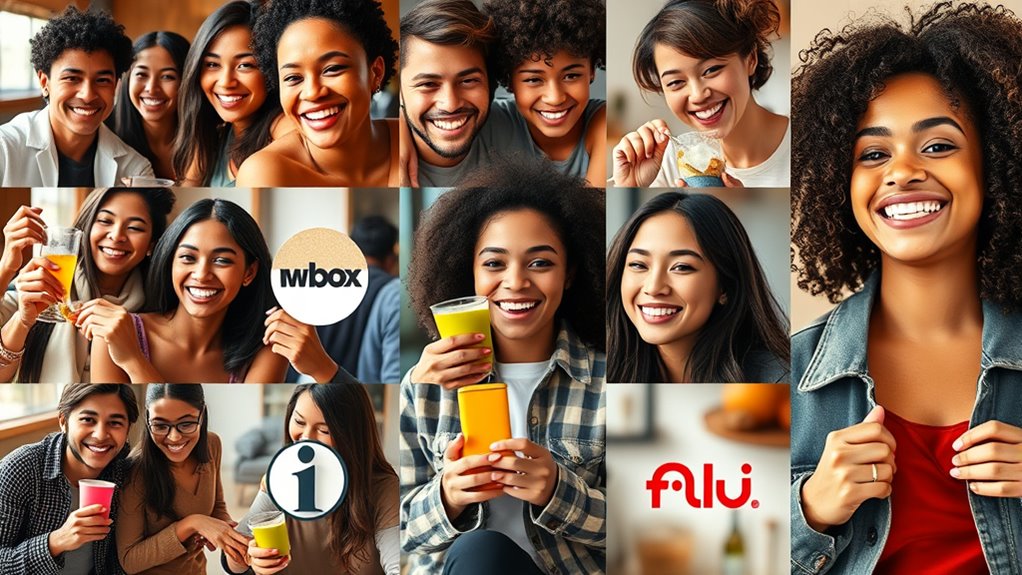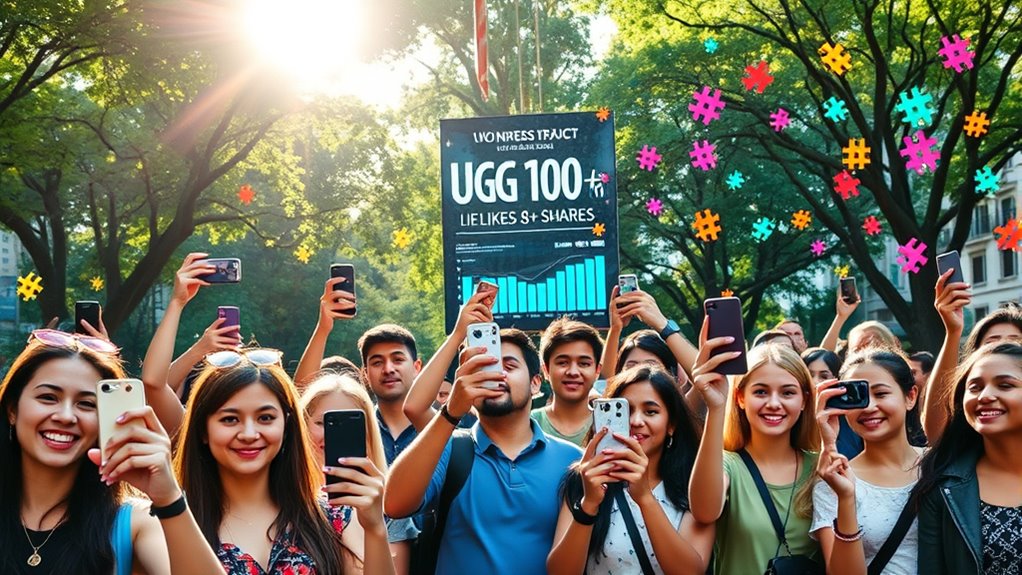User-generated content (UGC) has the power to transform social media by enhancing brand authenticity and fostering genuine connections with consumers. When you share your experiences, brands get a boost in credibility and trust, increasing interaction rates by 50%. UGC not only elevates brand awareness but also drives higher conversion rates, as it resonates more deeply with audiences. If you want to discover how to leverage UGC effectively, there’s much more to explore.
Key Takeaways
- User-generated content (UGC) enhances brand authenticity, making it 3.1 times more relatable than brand-created content.
- UGC significantly increases brand engagement, resulting in a 50% rise in interactions when featured in marketing strategies.
- Authentic UGC can boost conversion rates by up to 29%, driving higher purchase decisions among consumers.
- Incorporating UGC in advertising can achieve click-through rates four times higher than traditional ads, enhancing overall marketing effectiveness.
- Future trends show a shift towards real experiences, with increased reliance on short-form videos and collaboration with micro-influencers for niche markets.
Understanding User-Generated Content

User-generated content (UGC) is any content created and shared by individuals rather than brands or organizations on various platforms. This includes text posts, photos, videos, reviews, comments, and more, primarily found on social media, discussion forums, and wikis.
UGC stands out because it’s often spontaneous and heartfelt, making it relatable to other users. The internet and social media have made it easy for you to create and share your thoughts, whether for social recognition, self-expression, or even monetary gain.
You can collaborate with others, particularly on wikis, and engage in non-professional contexts. Ultimately, UGC enriches the online landscape by enhancing authenticity, diversity, and engagement, allowing you to contribute to a vibrant digital community.
The Impact of UGC on Brand Awareness

As consumers increasingly turn to social media for inspiration, the impact of user-generated content (UGC) on brand awareness has never been more significant. UGC expands your brand’s reach by tapping into networks unfamiliar with your products.
When customers share their experiences, especially with unique hashtags, it enhances brand exposure and creates a sense of authenticity. This authenticity boosts your brand’s credibility, making consumers more likely to trust you.
Additionally, UGC often goes viral, reaching broader audiences than traditional marketing. By analyzing engagement metrics, you can refine your UGC strategies effectively.
Engagement Boost: How UGC Drives Interaction

When you engage with user-generated content (UGC), you’re tapping into a powerful way to boost social interaction.
Authentic posts create genuine opportunities for connection, making your audience feel valued and involved.
This not only increases engagement but also strengthens the bond between your brand and its followers.
Increased Social Interaction
While many brands rely on polished, professionally produced content, engaging with user-generated content (UGC) can significantly enhance social interaction. UGC outperforms brand-generated content, driving engagement metrics higher.
When brands incorporate UGC into their social campaigns, they see a 50% increase in interaction. Content shared by employees garners eight times more engagement than standard brand posts, highlighting the power of personal touch. Additionally, brands that leverage low light office plants in their content have reported increased viewer interest and interaction, showcasing the effectiveness of relatable and practical user-generated themes.
By implementing a cross-channel UGC strategy, you can tap into diverse platforms to boost engagement further. UGC fosters community, encouraging users to participate and connect with your brand. This investment in user-generated content not only expands your reach but also cultivates a loyal audience eager to engage with your brand, ultimately promoting emotional health through shared experiences and connections.
Authentic Engagement Opportunities
User-generated content (UGC) offers brands authentic engagement opportunities that traditional advertising simply can’t match. It builds trust by showcasing real customer experiences, making your brand messages relatable and credible.
When users share their experiences in online forums, they cultivate a sense of community around your brand. This not only enhances brand perception but also drives higher engagement rates as customers actively participate.
UGC acts as social proof, influencing potential buyers by displaying products in real-life scenarios. To leverage these benefits, highlight real customer experiences, engage with feedback, and incorporate UGC into your campaigns.
The Role of UGC in Improving Conversion Rates

When it comes to boosting conversion rates, authenticity is key.
You’re likely to trust user-generated content more than traditional ads, which can lead to higher purchase rates.
Authenticity Drives Purchases
Authenticity plays a crucial role in driving purchases, as consumers increasingly seek genuine connections with brands.
When you showcase user-generated content (UGC), you tap into a powerful resource that boosts conversion rates by up to 29%. People find UGC 3.1 times more authentic than content created by brands, which builds their confidence—53% of shoppers feel more assured in their decisions when they see UGC.
Plus, campaigns featuring UGC see a 50% lift in engagement and achieve click-through rates four times higher than professionally crafted ads.
Enhanced Trust Factors
Trust is a crucial factor in driving conversions, and incorporating user-generated content (UGC) is one of the most effective ways to build that trust. When you include UGC in your marketing, you can boost conversion rates by 10%.
It’s not just about numbers; 84% of consumers are more inclined to trust brands that showcase UGC. People prefer visual content, with 85% choosing customer photos and videos over branded material.
Plus, engaging campaigns featuring UGC can lift customer interaction by 50%. Remember, 88% of shoppers consult reviews before buying, highlighting the importance of credibility.
Authenticity and Consumer Trust in UGC

As consumers increasingly seek genuine connections with brands, the authenticity of user-generated content (UGC) plays a pivotal role in shaping their trust.
You’re likely to find UGC 2.4 times more authentic than branded content, making it a powerful tool in your marketing strategy. With 90% of consumers prioritizing authenticity, it’s clear that they value real experiences over polished advertisements. Additionally, incorporating flavorful appetizers into your campaigns can resonate well with audiences by showcasing relatable, everyday moments.
UGC acts as social proof, influencing 79% of purchasing decisions and fostering community involvement. By sharing authentic customer experiences, you can build brand loyalty and engage your audience effectively. Additionally, incorporating diversification strategies in your marketing can enhance your brand’s reach and appeal to a wider audience.
UGC in Advertising: Performance Metrics

When you incorporate user-generated content (UGC) into your advertising, you can see a significant boost in click-through rates.
This increase isn’t just about numbers; it also helps enhance brand trust as consumers connect more with authentic content.
Click-Through Rate Boost
User-generated content (UGC) can significantly boost your click-through rate (CTR) in advertising, as it resonates more authentically with audiences. UGC ads typically achieve higher CTRs because they feel relatable and engaging.
To optimize your UGC campaigns, focus on key factors like ad placement and content quality. Setting clear campaign goals will also help you measure performance effectively.
CTR is a crucial metric, alongside others like conversion rates and engagement metrics, which provide insight into your ad’s effectiveness. To enhance your CTR, use authentic content from customers, target relevant audiences, and strategically place your ads.
Regularly monitor and adjust your campaigns to ensure you’re maximizing engagement and driving more clicks.
Enhanced Brand Trust
Trust plays a pivotal role in consumer relationships with brands, and leveraging user-generated content (UGC) can significantly enhance that trust. UGC is perceived as more authentic than traditional ads, showcasing real-life experiences that resonate with potential customers.
By serving as social proof, it builds credibility and demonstrates customer satisfaction, making it a powerful marketing tool. Engagement metrics like likes and shares indicate UGC’s positive impact on brand trust.
Additionally, UGC ads can boost conversion rates and memorability, creating unique content that stands out. This cost-effective strategy fosters brand loyalty by cultivating a sense of community.
Ultimately, embracing UGC helps shape a trustworthy brand reputation, especially among Millennials and Gen Z consumers who prioritize authenticity.
Harnessing UGC for Enhanced Email Marketing

Incorporating user-generated content (UGC) into your email marketing strategy can significantly elevate engagement and authenticity. By featuring customer reviews, photos, and testimonials, you build trust and showcase real-life experiences that resonate with your audience.
This not only fosters a sense of community but also enhances personalization, making your emails more relevant to recipients. UGC captures attention and naturally boosts engagement metrics like click-through and conversion rates.
Additionally, it’s cost-effective, allowing you to maintain a fresh content variety without breaking the bank. By integrating UGC, you create an omnichannel experience that encourages audience participation and strengthens brand loyalty.
Ultimately, UGC can transform your email campaigns into compelling narratives that drive results.
Strategies for Encouraging User-Generated Content

To encourage users to create content, brands should focus on fostering a sense of community and engagement.
Start by organizing social media contests and challenges that excite users and inspire them to share their experiences. Implement branded hashtags to aggregate user-generated content, making it easy for customers to connect.
Don’t forget to engage with your audience by responding to comments and spotlighting their contributions, which builds loyalty. You can also incentivize participation through discounts or giveaways.
Collaborate with influencers to reach broader audiences and encourage their followers to create content.
Lastly, track performance metrics to refine your strategies and ensure you’re meeting user expectations.
The Future of UGC: Trends and Predictions

As brands foster communities around user-generated content (UGC), it’s important to look ahead at the trends shaping its future.
You’ll notice a significant shift toward authenticity, with consumers favoring real experiences over polished ads. Short-form videos are becoming essential, especially on platforms like TikTok and Instagram.
Brands are increasingly collaborating with micro and nano creators to engage niche audiences. Additionally, AI will play a vital role in curating and optimizing UGC, enhancing creativity through co-creation.
Expect immersive experiences using AR and VR, alongside real-time data integration for dynamic engagement.
Case Studies: Successful UGC Campaigns

User-generated content (UGC) has proven to be a game changer for brands, capturing consumer attention and driving engagement like never before.
Take Calvin Klein’s #MyCalvins campaign, which inspired over 190,000 tagged photos on Instagram. GoPro’s ongoing #GoPro hashtag showcases 50 million posts from outdoor enthusiasts, while Spotify’s Wrapped campaign engages users by sharing personalized listening stats, prompting social shares.
Starbucks’ White Cup Contest invited creative submissions, boosting organic reach. Doritos’ Legion of the Bold fosters community through user-generated content.
Each of these campaigns highlights how UGC not only saves costs but also enhances authenticity and trust, leading to higher engagement and conversions.
Frequently Asked Questions
How Can Brands Measure UGC Effectiveness?
To measure UGC effectiveness, you should track engagement metrics like likes, shares, and comments to gauge user interaction.
Analyze conversion rates by monitoring click-through rates and sales influenced by UGC.
Additionally, assess brand awareness through reach metrics and unique hashtag campaigns.
Lastly, gather customer feedback and conduct sentiment analysis to understand how UGC shapes perceptions.
What Are the Legal Considerations for Using UGC?
When using user-generated content (UGC), you need to consider several legal factors.
First, respect copyright laws by obtaining permission from creators. Always check the platform’s terms of service to avoid issues.
If the UGC contains personal data, ensure compliance with privacy regulations. For commercial use, secure licensing agreements.
Lastly, be mindful of publicity rights and disclose any relationships with creators. Ignoring these aspects can lead to legal troubles you want to avoid.
How Do I Handle Negative UGC?
To handle negative UGC, you need to act quickly and thoughtfully.
First, monitor your platforms for harmful content and respond promptly. Address the issue directly and respectfully, showing you care about your audience’s concerns.
Establish clear content guidelines and use a mix of human and technology moderation to maintain quality.
Lastly, remove any offending content to protect your brand’s reputation and reassure your community that you’re committed to a positive experience.
Can UGC Be Used in Paid Advertising?
Absolutely, you can use user-generated content (UGC) in paid advertising! Incorporating UGC can boost your ad engagement significantly since it resonates more with your audience.
It’s cost-effective too, allowing you to leverage content created by your customers. Just make sure you get permission before using their work.
When done right, UGC not only enhances authenticity but also improves your ad performance, leading to better returns on your investment.
What Tools Can Help Manage UGC Campaigns?
To manage your UGC campaigns effectively, consider tools like Social Native for collecting and curating content, or Onstipe for easy hashtag tracking.
Stackla provides real-time analytics to measure performance, while Tint offers customizable displays.
For a more integrated approach, Pixlee creates shoppable galleries and tracks engagement.
Taggbox manages UGC across various marketing channels, ensuring you’ve got everything you need to maximize your campaign’s impact and reach your audience effectively.
Conclusion
User-generated content is a game-changer for brands looking to connect with their audience. By leveraging UGC, you not only boost engagement and trust but also enhance your marketing strategies across platforms. As consumers increasingly seek authenticity, can you afford to overlook the power of their voices? Embracing UGC isn’t just a trend; it’s a necessity for building lasting relationships with your customers and driving conversions. So, start tapping into this valuable resource today!



![Trap Beat Mixing Tutorial [Extended Version] 23 TRAP BEAT MIXING TUTORIAL EXTENDED VERSION](https://strongmocha.com/wp-content/uploads/2019/08/TRAP-BEAT-MIXING-TUTORIAL-EXTENDED-VERSION.png)





